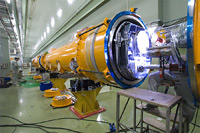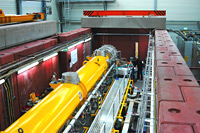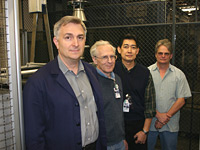 |
|
|
 |
STF – Getting ready for the experience

Crew welding the pipes at the far upstream end of the cryostat (TESLA-type cavity part). |
An important prerequisite for building the ILC is to establish the design and manufacturing of major and vital components, such as cryomodules for the main linacs through realistic operating conditions. The Tesla Test Facility (FLASH) at DESY and Fermilab’s ILC Test Area have been pursued to play critical roles in the European and American regions to this end. KEK also aims to serve as an Asian regional center for the main linac technology, and their STF (Superconducting RF Test Facility) and R&D programs are a manifestation of its endeavour. Many members of STF from KEK are active members in the GDE and in close collaborative relationships with colleagues from DESY, INFN, Orsay, FNAL, JLab, Cornell and SLAC. Major laboratories from China, Korea, and India, have expressed their interests or have already begun interactions with the programme at STF in various forms also.
Read more...
-- Nobuko Kobayashi |
 |
|
|
 |
Upcoming meetings, conferences, workshops
ILCDR07 - Damping Rings R&D Meeting
LNF-INFN, Frascati, Italy
5-7 March 2007
The LHC Early Phase for the ILC
Fermilab, Batavia, Illinois
12-14 April 2007
TESLA Technology Collaboration Meeting
Fermilab, Batavia, Illinois
23-26 April 2007
MAC Meeting
Fermilab
26-27 April 2007
DOE/NSF ILC Americas Regional Team Review
Fermilab
30 April - 2 May
Annual WILGA Conference
Warsaw University of Technology Resort, Poland
21-27 May 2007
 LCWS 2007 LCWS 2007
Hamburg, Germany
30 May - 4 June 2007
View Full Calendar...
|
|
 = Collaboration-wide Meetings = Collaboration-wide Meetings
GDE Meetings Calendar |
|
|
 |
Testing, Testing

A brand-new test stand at DESY puts complete modules under the test. The performance of the module, its cavities, couplers and cables can be examined in great detail. |
Module 6 has had a bit of a break since we last reported on its progress (NewsLine 11 May 2006 and NewsLine 15 June 2006). It spent the last few months in DESY’s new module test stand in a brand-new building – as sparkling as new buildings in research centres get – and hasn’t been idle. Several cooling cycles and all sorts of tests over several months made sure that its creators knew the exact behaviour of all cavities, cables and couplers, the slow and fast tuners and the magnet.
Read more...
-- Barbara Warmbein |
 |
|
|
 |
From Interactions.org
28 February 2007
Giant magnet goes underground at CERN
Geneva, 28 February 2007. At 6:00 am this morning the heaviest piece of the Compact Muon Solenoid (CMS) particle detector began a momentous journey into its experimental cavern, 100 metres underground at CERN[1].
Read more... |
|
From SLAC Today
23 February 2007
New Modulator Technology Looks Feasible for ILC
A new type of modulator developed at SLAC reached important milestones on Wednesday, making it feasible to more reliably and less expensively provide power to accelerate particles at the proposed International Linear Collider (ILC).
Read more... |
|
From The National Academies
22 February 2007
Scientists Release Designs for Particle Accelerator
An international group of 60 scientists has released initial designs for the International Linear Collider. If constructed, the machine would slam subatomic particles with opposing energies into each other to simulate the conditions that occurred moments after the universe was created.
Read more... |
|
From SLAC Today
22 February 2007
Tracking Extraordinary Particles in the ILC
With the recent release of the Reference Design Report, the International Linear Collider (ILC) is beginning to take shape. As the design progresses, researchers around the world are concocting new ways to detect exotic particles. Here at SLAC, a group of physicists are leading the design effort for the innovative Silicon Detector (SiD), one of four proposed particle hunters for the ILC.
Read more... |
|
|
 |
ILC Baseline Alternative: The Marx Modulator

Greg Leyh, Piotr Bloom, Alfred Viceral and Jeff Olsen of the SLAC team |
Today’s issue of ILC NewsLine features a special column written jointly by GDE Director Barry Barish and Ray Larsen of SLAC.
The release of the ILC Reference Design was a very important milestone. Yet, we have emphasised that it is really a snapshot of the ILC design. It is not the ILC we will build, and it will evolve significantly as we move forward. In our Baseline Configuration Document (BCD) that we published more than a year ago, we documented a set of alternatives to the baseline. The alternatives, though not mature enough to be chosen over the baseline, potentially could improve the performance, or reduce cost or risk. We are pursuing a vigorous R&D program to develop the alternatives, and this past week we accomplished a notable success when the Marx Modulator passed a major milestone.
Read more...
-- Barry Barish and Ray Larsen
Director's Corner Archive |
|

